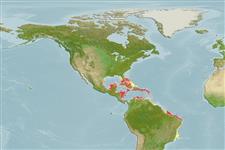Common names from other countries
Environment: milieu / climate zone / depth range / distribution range
Ecologia
marinhas associadas(os) a recifes; intervalo de profundidade 5 - 20 m (Ref. 9710). Tropical
Western Central Atlantic: Florida (USA), Bahamas, Puerto Rico, Grand Cayman Island, Virgin Islands, Antigua, Barbados, Aruba, Curaçao, Colombia, and Venezuela.
Tamanho / Peso / Idade
Maturity: Lm ? range ? - ? cm
Max length : 8.5 cm TL macho/indeterminado; (Ref. 7251)
Espinhos dorsais (total) : 18 - 21; Raios dorsais moles (total) : 31 - 36; Espinhos anais: 2; Raios anais moles: 33 - 37. Light brown with pale dots and a narrow mid-lateral brown stripe, sometimes broken into blotches; faint bars on body; small black spot at front of dorsal fin; mature males with more yellow on head, gill membranes black; branchiostegal rays blue (Ref. 13442).
Occurs in groups, one to a hole, in limestone or coral rubble in clear water. Feeds on small crustaceans, worms, and fishes (Ref. 5521).
Life cycle and mating behavior
Maturities | Reprodução | Spawnings | Egg(s) | Fecundities | Larvas
Robins, C.R. and G.C. Ray, 1986. A field guide to Atlantic coast fishes of North America. Houghton Mifflin Company, Boston, U.S.A. 354 p. (Ref. 7251)
Categoria na Lista Vermelha da IUCN (Ref. 130435)
CITES (Ref. 128078)
Not Evaluated
Ameaça para o homem
Harmless
Utilização humana
Pescarias: espécies comerciais; Aquário: Espécies comerciais
Ferramentas
Relatórios especiais
Descarregue XML
Fontes da internet
Estimates based on models
Preferred temperature (Ref.
115969): 26.4 - 28.2, mean 27.5 (based on 520 cells).
Phylogenetic diversity index (Ref.
82804): PD
50 = 0.5010 [Uniqueness, from 0.5 = low to 2.0 = high].
Bayesian length-weight: a=0.00457 (0.00183 - 0.01143), b=3.08 (2.86 - 3.30), in cm Total Length, based on LWR estimates for this (Sub)family-body shape (Ref.
93245).
Nível Trófico (Ref.
69278): 3.7 ±0.55 se; based on food items.
Fishing Vulnerability (Ref.
59153): Low vulnerability (10 of 100).
